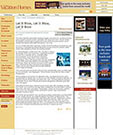Let It Blow, Let It Blow, Let It Blow
Hurricane-Resistant Materials Help Keep the Roof Over Your Head
 Robb Report Article, May 2006 - Author: Karen J. Bannan. The news channels played the haunting images over and over: gorgeous homes being ripped to pieces as their roofs flew off. Americans were voyeurs of the devastation and damage brought forth by the 2005 hurricane season, which started with Arlene and ended with Epsilon—26 in all.
Robb Report Article, May 2006 - Author: Karen J. Bannan. The news channels played the haunting images over and over: gorgeous homes being ripped to pieces as their roofs flew off. Americans were voyeurs of the devastation and damage brought forth by the 2005 hurricane season, which started with Arlene and ended with Epsilon—26 in all.
It is no wonder then that a growing number of home building manufacturers are launching or highlighting products designed to keep a home’s contents safely inside when dangerous winds are howling outside.
Dr. Bill Applegate, a Shell Point, Fla., resident, is taking advantage of one such technology. Applegate recently moved into a Topsider Home, a prefabricated post-and-beam house designed to withstand hurricane-force winds, heavy snow loads and earthquakes. The 2,300-square-foot unit was completed in July 2005, three days before Hurricane Dennis hit. The home, which can be built out up to 12,000 square feet, withstood the storm because of its octagonal shape, special glass fittings and concrete pedestal. )
"The wind got up to around 90 miles per hour and the tides were up pretty high, but we were fine," says Applegate. "Some homes not terribly far away simply disappeared."
While building a new home is an attractive idea, manufacturers know some people prefer to retrofit their existing house with weather-resistant materials. To that end, DaVinci Roofscapes of Kansas City, Kan., and FutureStone, based in Fort Worth, Texas, have introduced products designed to withstand up to 250 mph wind gusts.
FutureStone’s technology replaces typical wood walls with insulating concrete form (ICF). It is nine times stronger than a traditional wood foundation and has achieved a 250 mph wind rating. "Technology, which was previously used for safe rooms, has migrated to the mainstream market," says FutureStone president Cameron Ware.
ICF, which can be used for new, as well as existing, construction, has Styrofoam on the outside and can be snapped together like plastic building blocks. The blocks are filled with metal rebar, then filled with concrete. Sheetrock or stucco is screwed onto the outside so that the home looks like any other. It is also mold, sound and temperature resistant. The cost is only 3 to 5 percent more than traditional building materials. It is so solid that its UL fire rating is three or four hours. A typical wood frame home will burn in about one hour.
Today, more than 85 percent of homes—even some of the most exclusive—have asphalt shingles, which can blow off in a storm. The other 15 percent have shingles made of slate, tile, metal or clay, which can be better insulators and more aesthetically pleasing, but often become 10-pound projectiles in a storm. DaVinci Roofscapes’ roof shingles are synthetic versions of the high-end products—they look like slate but weigh only about one pound each, passed certifications of up to 110 mph wind resistance and have the highest impact resistance and fire resistance available.
While using the best building products is important, one expert explains that they are just part of the equation. "You could have the best shingles in the world, but if some idiot just puts one nail in each shingle, the shingles are going to fly off," explains Paul Fisette, professor and director of the Building Materials and Wood Technology program at the University of Massachusetts in Amherst. "You have to meet code. You have to pay attention to a product’s claims."
Applegate agrees. "I thought my home was attractive, but it came down to everything being hurricane-resistant and the construction method being solid," he says. "You have to plan for every eventuality."



